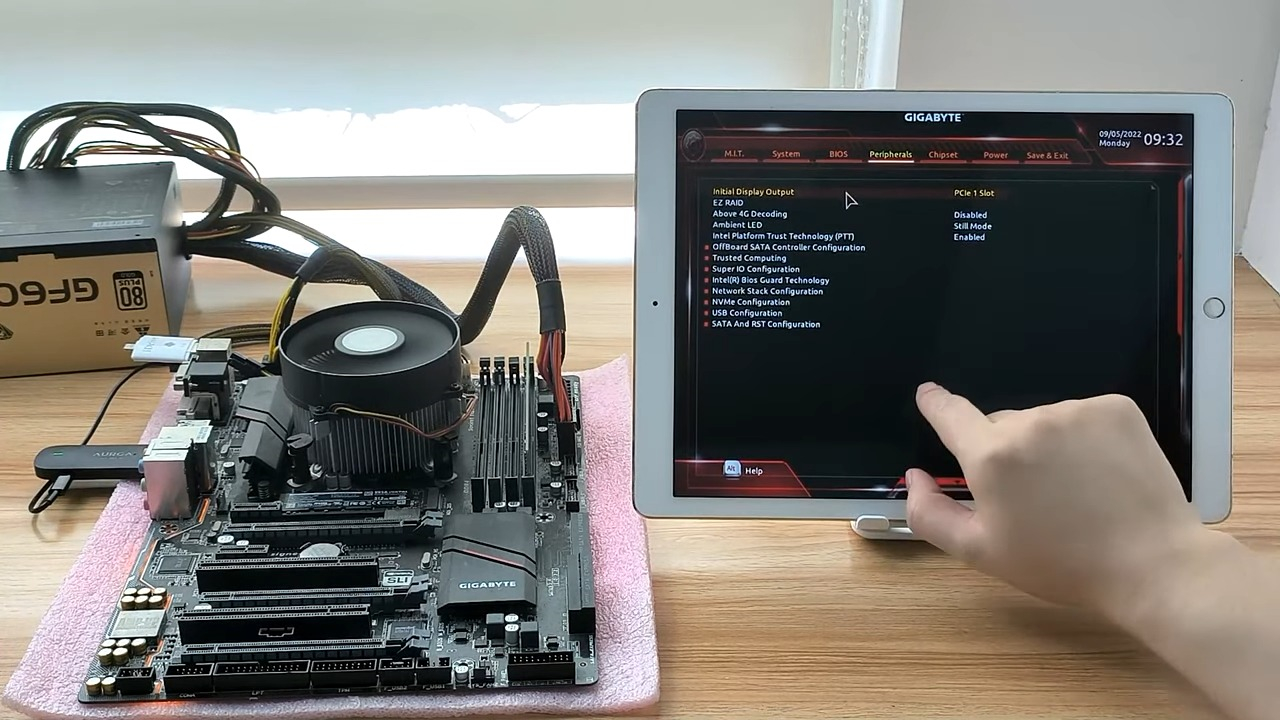Aurga Viewer is a $79 wireless dongle that can remote control any device, even a headless PC with no OS installed.
This nifty device either lets anything with an HDMI and a USB be used by other devices, or have its display transmitted to another display!

It happens to us all the time. You're in the middle of building a PC or just testing a bare motherboard outside of a case and you want to boot up, get to the BIOS and see what's going on. Under normal circumstances, you'd have to bring a monitor, keyboard and mouse to the computer, just to find out if it boots. However, a new $79 device makes testing PCs (and other headless devices) easy as it provides platform-agnostic remote control, just from being plugged into a single HDMI and USB port.
The Aurga Viewer is a nifty little dongle that plugs into any secondary device (including a PC), and then pairs wirelessly to a client device that has the Aurga app installed. The host device doesn't need any software installed so you can use the dongle on a PC that has no OS installed or on any device that outputs video over HDMI and takes peripheral input via USB.

The Aurga Viewer is meant to be used for video/ audio streaming, as a way to control a connected device -- or both. The form factor is compact and doesn't need any external power,r as it draws 240-280mA/ 5V, complying with USB 2.0 standards.
Unlike some dongles that work by having an app installed on the secondary device, you get a complete display and control access. But it can transmit from any device with an HDMI port, so it works on but is not limited to PCs, gaming consoles, cameras, Single Board Computers (SBCs) like Raspberry Pi and TV boxes. It also lets you connect your device to VR glasses.
Wireless Input/Output Ability
As an example of its display capabilities, the demo video above shows it being used to connect iPad to a PC for use as a touchscreen controller for BIOS access. As seen in the demo, the app installed on the device controls the primary device and lets you either use the keyboard to type or a finger to mouse around -- the app provides input options to the primary device.
This scenario is a good example of how it operates, as the host device transmits HDMI signals, while using a USB port for input devices and power. Since it now has Linux support, I suppose you could install its Linux app on a Steam Deck, making it a client device, as SteamOS is based on Linux. The same should be possible for ASUS' ROG Ally, which runs on Windows 11. Both portable gaming devices have touch screens with USB and video output, giving them the ability to be used as client devices (or host devices if you have a USB-to-HDMI adapter for their video out).
The Aurga Viewer is hardware agnostic, so long as the device has an HDMI out and a USB connector it should work, although you may need an adapter if the device doesn't have a Type-C port. The primary device that displays and/ or controls it will need to be using Windows, Linux, Android, iOS, or MacOS and have the app installed on the primary device.
Get Tom's Hardware's best news and in-depth reviews, straight to your inbox.
Many Potential Applications

One of the best scenarios I can think of is to connect the Aurga to a headless system, then use your main PC with the Aurga Viewer app, removing the need to have an extra display, mouse, and keyboard. Another idea is to shift your graphic design software between the PC/ Mac to a wireless tablet with a pen, eliminating the need for a dedicated pen tablet. Similarly, you can wirelessly play and stream from any portable device to a device or a system with a bigger display, giving you or others the freedom to see your gameplay.
Aurga lets you bridge the Viewer to your 5-GHz-capable wireless router, which is also connected to a system or a device with the Aurga app. You cannot use it over the Internet. As long as you're on the same network and close enough not to experience lag, that's your sweet spot.
The dongle weighs 14.5 grams and hence does not add any significant weight to your portable device. So not only does the client device display what's running through the Aurga Viewer, but it also allows it to extend to a wireless device and use it as a secondary monitor at 1080p resolution with 48KHz audio quality.
Of course, there are a lot of ways that something like this can be useful. It would be great if it had higher resolution and lower latency for things like gaming. The company says it's optimized for low latency for video streaming, not high-speed gaming. But to be fair, the company wanted the device to work with everything, including single-board computers like the Raspberry Pi.
The Aurga team debuted this device on Kickstarter and was able to raise over $150,000. The team is based in Kowloon, Hong Kong. Now that it is out of its Kickstarter phase, you can purchase the Aurga Viewer from its website for US $79, making it an incredible value if you have a use (or five) for a device like this.

Roshan Ashraf Shaikh has been in the Indian PC hardware community since the early 2000s and has been building PCs, contributing to many Indian tech forums, & blogs. He operated Hardware BBQ for 11 years and wrote news for eTeknix & TweakTown before joining Tom's Hardware team. Besides tech, he is interested in fighting games, movies, anime, and mechanical watches.
-
BerMM Did you actually spend any time with it? I've spent plenty of time trying to get mine to work. I'd probably love it if it worked as promised. Currently it is a good reminder of how easily I can waste money if I'm not careful. :(Reply -
dmitche31958 I would like to know if I could connect it to my Samsung TV and use it as a keyboard and see what is being shown on the TV. If I could change inputs to play my USB drives or to stream from my Roku.Reply -
edzieba A shame it's HDMI-based rather than DP-based, that limits its utility outside of basic consumer devices.Reply -
az_r2d1 Reply
On a headless pc, look at the bios for instance ?? Don't think that would work.Serhii said:Sounds like KVM over IP, just need to use some PC via TeamViewer, RDP or VNC. -
az_r2d1 Reply
Can you elaborate what's not working?BerMM said:Did you actually spend any time with it? I've spent plenty of time trying to get mine to work. I'd probably love it if it worked as promised. Currently it is a good reminder of how easily I can waste money if I'm not careful. :( -
jasonvr Anyone wanna take bets on how much was stolen from the PiKVM project to make this dongle? Been running a PiKVM based on a PiZero on my home server for a while and it's greatReply